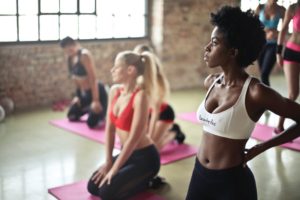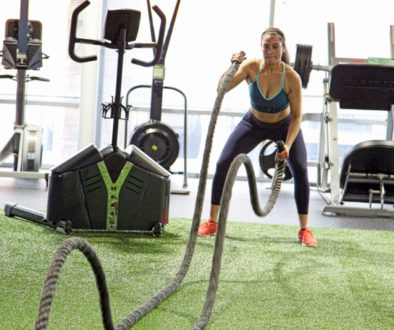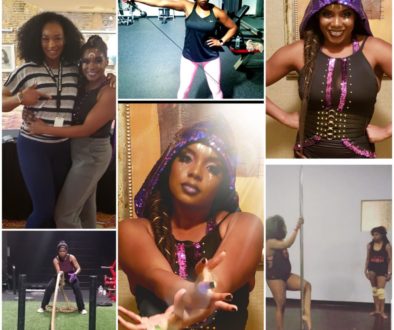Have Safe Flex
Although the title of this blog post refers to flexibility, as it was sparked by the recent posting of an extremely alarming and dangerous video, this concern really applies to all types of classes and teaching. There’s a video floating around of a instructor manually putting students into a contorted position. This “technique” was not only unsafe but potentially paralyzing, and could have left someone seriously hurt. Not only were these students being forced into a position, they had a rod pressed against their cervical spine (not at all where the pole should even be if you’re properly performing a spatchcock). On top of that, after being warped around the rod, they were pulled upright by the bar onto their tailbones and then turned onto their backs. I cringed as as I watched this, and I cringe as I continue to discuss this with others in the industry. And to quote another fellow instructor: “the heels, the ankles, the knees! So many potential injuries.” Training methods should not put students at risk for injury…point blank. There were just so many areas where things could have gone wrong, and for no reason because there are so many safer ways to train this particular skill.
 Now, my goal is not to shame those involved, but rather to shed light on the need for responsible teaching. While many of the extreme training methods being shared socially are full of ooh and awe, these so called novelty techniques are dangerous and can lead to serious injury. There are safer, smarter ways to achieve the skills you desire. As instructors (or anyone that has a social media following/fan base) we need to be cautious about the teaching and training methods we share because people are watching and many of them try to replicate what they see. The only thing worse than seeing this video unfold, were the comments on the video. People (who I’m sure didn’t know any better) were impressed. With over 10k views and hundreds of comments left on this video, it’s definitely generating a lot of attention. However, many of the comments are from viewers praising the post and calling it genius and stating their desire to try this same “technique”. And this is not the first incident of this type. Last year a video surfaced of a cheer coach that was forcing a student into splits, which led to the young lady being serious injury. Not only was her body not ready for that position, she was clearly in panic mode and tensed up, which only further added her pain and suffering because her body was in the flight or fight phase. Then there was a workshop that I attended a while back with a cirque professional, that consisted of no warmup and then her preceding to place us in vulnerable positions and sit on us, all while knowing nothing about us or our ability levels. These tactics are UNACCEPTABLE.
Now, my goal is not to shame those involved, but rather to shed light on the need for responsible teaching. While many of the extreme training methods being shared socially are full of ooh and awe, these so called novelty techniques are dangerous and can lead to serious injury. There are safer, smarter ways to achieve the skills you desire. As instructors (or anyone that has a social media following/fan base) we need to be cautious about the teaching and training methods we share because people are watching and many of them try to replicate what they see. The only thing worse than seeing this video unfold, were the comments on the video. People (who I’m sure didn’t know any better) were impressed. With over 10k views and hundreds of comments left on this video, it’s definitely generating a lot of attention. However, many of the comments are from viewers praising the post and calling it genius and stating their desire to try this same “technique”. And this is not the first incident of this type. Last year a video surfaced of a cheer coach that was forcing a student into splits, which led to the young lady being serious injury. Not only was her body not ready for that position, she was clearly in panic mode and tensed up, which only further added her pain and suffering because her body was in the flight or fight phase. Then there was a workshop that I attended a while back with a cirque professional, that consisted of no warmup and then her preceding to place us in vulnerable positions and sit on us, all while knowing nothing about us or our ability levels. These tactics are UNACCEPTABLE.
As instructors, it’s okay to have the urge to get creative with our teaching methods. I mean it does keep classes interesting and enjoyable, but safety should ALWAYS take precedent over creativity. Practicing safe teaching methods is only the tip of the iceberg. There’s more areas of concern that keep arising. Instructors and students reading this, please pay attention to these things in the classes you teach/attend. When trying to make your body healthier, stronger, more flexible you should not be putting it in more danger. So what should we see more of in classes and training?
Gentle Coaching and Proper Technique:
Students should never be placed or forced into any position. It’s okay to coach them, guide them, provide tactical cues and make minor adjustments HOWEVER we shouldn’t be manually manipulating them into forced poses that they clearly aren’t ready for. This also includes not sitting on students. This is especially true (1) when it comes to the pole/aerial world where we have a lot of older adults that come in with little to no experience or previous training and are more susceptible to injury and (2) when it comes to workshops or other instances where you are training people that you aren’t familiar with their bodies and ability levels. Hell, I barely even touch new students. Which I admit can come off as favoritism towards vets, but really it’s for their own safety. I like to get to know my students ability, challenges, bodies, etc before just jumping in and physically torturing them (insert evil smile here).
Proper and thorough warm-up
Warm ups are just that: to WARM THE BODY UP and get it prepped for the workout. That means the heart rate and body temperature should rise, increase blood flow to the joints, ligaments and tendons. Hopefully, you get slightly out of breath and break a sweat. I’ve seen, heard and been to classes that had insufficient warmups and it’s scary. Along the same lines, because my warmups are thorough, for some they are seen as too intense and has scared a few people away. I’m okay with that. I’d rather have you warmed up properly and mad at me than put you at risk for injury. 
Leveling and Sequencing
How instructors prepare and train students for tricks/skills is important. Hint: there’s a reason why we go through grade school before high school and college, and why we learn our ABC’s first before reading and writing essays. A solid foundation helps set you up for success and reduce risk of injury. Ensuring that are properly primed by focusing on form, breaking skills down into levels and sequencing the foundational building blocks is key. From there ensuring that they not only know, but practice, proper technique, and form while providing progressions, strengthening and conditioning should also be a part of the process.
Continuing education and training
As instructors, we should never stop learning. Whether you’re investing in training courses or doing solo studying, we should always keep working to improve our craft and knowledge and keep up with the advancements of our students and the evolving aerial/fitness industry.
Referrals…Yep, don’t be afraid to refer a student elsewhere
I don’t know everything and you know what? I’m OKAY with that. No one knows everything. So if a student asks me something that’s outside of my expertise, I am quick to refer them to a doctor, sports doctors, chiropractor or massage therapist. Why speculate when I can send them to someone qualified to assess, diagnose and treat? If it’s something I feel like I probably should be more familiar with or want to know more about then I will take the time to research and learn more about it. Along those same lines, I follow up to see what the outcome was so I can add that knowledge to my toolbox for the future, AND because I care!
That being said, instructors we need to do better! Not just in teaching but also in educating our students. Students, please don’t let instructors do just anything to you. If something doesn’t seem right or feel right, don’t do it. Speak up, ask questions, raise concerns. You only get ONE body. Do not comprise your health and well-being in pursuit of a goal. Know that whatever skills/abilities you desire, they can be achieved but you want to go through the proper channels so that you can safely achieve those skills.
Questions, thoughts, concerns? Want more details on how to train safely? Give me a shout!




